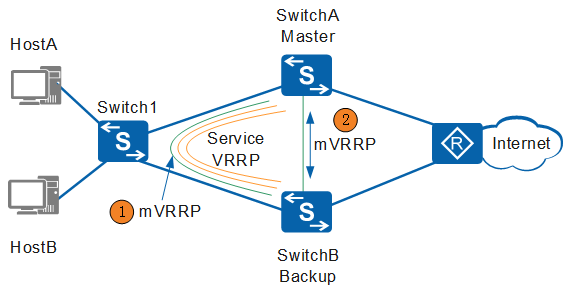mVRRP
A switch is typically dual-homed to two devices for improved network reliability and multiple VRRP groups are configured on both devices to transmit various types of services. Each VRRP group needs to maintain its own state machine; therefore, a large number of VRRP Advertisement packets are transmitted between devices.
Management Virtual Router Redundancy Protocol (mVRRP) solves this issue by decreasing bandwidth and CPU resources occupied by protocol packets. You can configure a VRRP group as an mVRRP group and bind other VRRP groups to the mVRRP group. Figure 1 shows the typical mVRRP networking. The mVRRP group sends VRRP Advertisement packets to determine the master and backup status for its VRRP groups. The bound VRRP groups do not send VRRP Advertisement packets and the VRRP status is the same as the mVRRP group status.
mVRRP group
An mVRRP group has all the functions of a common VRRP group, and determines the states of its member VRRP groups by sending VRRP Advertisement packets. An mVRRP group can be deployed on the same side as service VRRP groups or on the interfaces that directly connect SwitchA and SwitchB. Whether an mVRRP group forwards traffic depends on whether it functions as the gateway:When an mVRRP group functions as the gateway (mVRRP1 in Figure 1), the mVRRP group determines the Master and Backup states and forwards service traffic. You must first create a VRRP group and configure a virtual IP address as the gateway address, and then configure this VRRP group as an mVRRP group.
When an mVRRP group does not function as the gateway (mVRRP2 in Figure 1), the mVRRP group only determines the master and backup states, and cannot forward service traffic. The mVRRP group does not require a virtual IP address, and you can directly create an mVRRP group on an interface. mVRRP simplifies maintenance.
Service VRRP group
After common VRRP groups are bound to an mVRRP group, they become service VRRP groups (member VRRP groups). Service VRRP groups do not need to send VRRP Advertisement packets to determine their status. The mVRRP group sends VRRP Advertisement packets to determine its status and the status of all its bound service VRRP groups.
